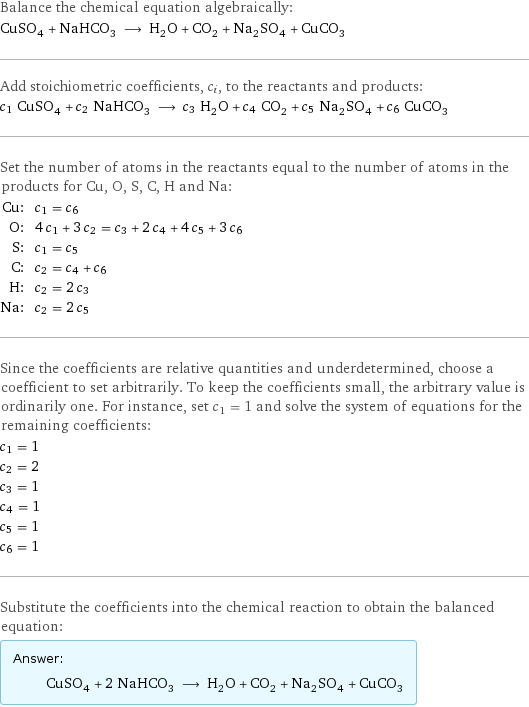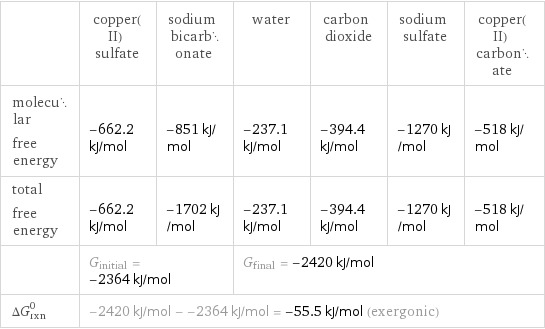Input interpretation

CuSO_4 copper(II) sulfate + NaHCO_3 sodium bicarbonate ⟶ H_2O water + CO_2 carbon dioxide + Na_2SO_4 sodium sulfate + CuCO_3 copper(II) carbonate
Balanced equation

Balance the chemical equation algebraically: CuSO_4 + NaHCO_3 ⟶ H_2O + CO_2 + Na_2SO_4 + CuCO_3 Add stoichiometric coefficients, c_i, to the reactants and products: c_1 CuSO_4 + c_2 NaHCO_3 ⟶ c_3 H_2O + c_4 CO_2 + c_5 Na_2SO_4 + c_6 CuCO_3 Set the number of atoms in the reactants equal to the number of atoms in the products for Cu, O, S, C, H and Na: Cu: | c_1 = c_6 O: | 4 c_1 + 3 c_2 = c_3 + 2 c_4 + 4 c_5 + 3 c_6 S: | c_1 = c_5 C: | c_2 = c_4 + c_6 H: | c_2 = 2 c_3 Na: | c_2 = 2 c_5 Since the coefficients are relative quantities and underdetermined, choose a coefficient to set arbitrarily. To keep the coefficients small, the arbitrary value is ordinarily one. For instance, set c_1 = 1 and solve the system of equations for the remaining coefficients: c_1 = 1 c_2 = 2 c_3 = 1 c_4 = 1 c_5 = 1 c_6 = 1 Substitute the coefficients into the chemical reaction to obtain the balanced equation: Answer: | | CuSO_4 + 2 NaHCO_3 ⟶ H_2O + CO_2 + Na_2SO_4 + CuCO_3
Structures

+ ⟶ + + +
Names

copper(II) sulfate + sodium bicarbonate ⟶ water + carbon dioxide + sodium sulfate + copper(II) carbonate
Reaction thermodynamics
Enthalpy

| copper(II) sulfate | sodium bicarbonate | water | carbon dioxide | sodium sulfate | copper(II) carbonate molecular enthalpy | -771.4 kJ/mol | -950.8 kJ/mol | -285.8 kJ/mol | -393.5 kJ/mol | -1387 kJ/mol | -595 kJ/mol total enthalpy | -771.4 kJ/mol | -1902 kJ/mol | -285.8 kJ/mol | -393.5 kJ/mol | -1387 kJ/mol | -595 kJ/mol | H_initial = -2673 kJ/mol | | H_final = -2661 kJ/mol | | | ΔH_rxn^0 | -2661 kJ/mol - -2673 kJ/mol = 11.57 kJ/mol (endothermic) | | | | |
Gibbs free energy

| copper(II) sulfate | sodium bicarbonate | water | carbon dioxide | sodium sulfate | copper(II) carbonate molecular free energy | -662.2 kJ/mol | -851 kJ/mol | -237.1 kJ/mol | -394.4 kJ/mol | -1270 kJ/mol | -518 kJ/mol total free energy | -662.2 kJ/mol | -1702 kJ/mol | -237.1 kJ/mol | -394.4 kJ/mol | -1270 kJ/mol | -518 kJ/mol | G_initial = -2364 kJ/mol | | G_final = -2420 kJ/mol | | | ΔG_rxn^0 | -2420 kJ/mol - -2364 kJ/mol = -55.5 kJ/mol (exergonic) | | | | |
Equilibrium constant
![Construct the equilibrium constant, K, expression for: CuSO_4 + NaHCO_3 ⟶ H_2O + CO_2 + Na_2SO_4 + CuCO_3 Plan: • Balance the chemical equation. • Determine the stoichiometric numbers. • Assemble the activity expression for each chemical species. • Use the activity expressions to build the equilibrium constant expression. Write the balanced chemical equation: CuSO_4 + 2 NaHCO_3 ⟶ H_2O + CO_2 + Na_2SO_4 + CuCO_3 Assign stoichiometric numbers, ν_i, using the stoichiometric coefficients, c_i, from the balanced chemical equation in the following manner: ν_i = -c_i for reactants and ν_i = c_i for products: chemical species | c_i | ν_i CuSO_4 | 1 | -1 NaHCO_3 | 2 | -2 H_2O | 1 | 1 CO_2 | 1 | 1 Na_2SO_4 | 1 | 1 CuCO_3 | 1 | 1 Assemble the activity expressions accounting for the state of matter and ν_i: chemical species | c_i | ν_i | activity expression CuSO_4 | 1 | -1 | ([CuSO4])^(-1) NaHCO_3 | 2 | -2 | ([NaHCO3])^(-2) H_2O | 1 | 1 | [H2O] CO_2 | 1 | 1 | [CO2] Na_2SO_4 | 1 | 1 | [Na2SO4] CuCO_3 | 1 | 1 | [CuCO3] The equilibrium constant symbol in the concentration basis is: K_c Mulitply the activity expressions to arrive at the K_c expression: Answer: | | K_c = ([CuSO4])^(-1) ([NaHCO3])^(-2) [H2O] [CO2] [Na2SO4] [CuCO3] = ([H2O] [CO2] [Na2SO4] [CuCO3])/([CuSO4] ([NaHCO3])^2)](../image_source/f75befcd6d359da44dcb322b657ef930.png)
Construct the equilibrium constant, K, expression for: CuSO_4 + NaHCO_3 ⟶ H_2O + CO_2 + Na_2SO_4 + CuCO_3 Plan: • Balance the chemical equation. • Determine the stoichiometric numbers. • Assemble the activity expression for each chemical species. • Use the activity expressions to build the equilibrium constant expression. Write the balanced chemical equation: CuSO_4 + 2 NaHCO_3 ⟶ H_2O + CO_2 + Na_2SO_4 + CuCO_3 Assign stoichiometric numbers, ν_i, using the stoichiometric coefficients, c_i, from the balanced chemical equation in the following manner: ν_i = -c_i for reactants and ν_i = c_i for products: chemical species | c_i | ν_i CuSO_4 | 1 | -1 NaHCO_3 | 2 | -2 H_2O | 1 | 1 CO_2 | 1 | 1 Na_2SO_4 | 1 | 1 CuCO_3 | 1 | 1 Assemble the activity expressions accounting for the state of matter and ν_i: chemical species | c_i | ν_i | activity expression CuSO_4 | 1 | -1 | ([CuSO4])^(-1) NaHCO_3 | 2 | -2 | ([NaHCO3])^(-2) H_2O | 1 | 1 | [H2O] CO_2 | 1 | 1 | [CO2] Na_2SO_4 | 1 | 1 | [Na2SO4] CuCO_3 | 1 | 1 | [CuCO3] The equilibrium constant symbol in the concentration basis is: K_c Mulitply the activity expressions to arrive at the K_c expression: Answer: | | K_c = ([CuSO4])^(-1) ([NaHCO3])^(-2) [H2O] [CO2] [Na2SO4] [CuCO3] = ([H2O] [CO2] [Na2SO4] [CuCO3])/([CuSO4] ([NaHCO3])^2)
Rate of reaction
![Construct the rate of reaction expression for: CuSO_4 + NaHCO_3 ⟶ H_2O + CO_2 + Na_2SO_4 + CuCO_3 Plan: • Balance the chemical equation. • Determine the stoichiometric numbers. • Assemble the rate term for each chemical species. • Write the rate of reaction expression. Write the balanced chemical equation: CuSO_4 + 2 NaHCO_3 ⟶ H_2O + CO_2 + Na_2SO_4 + CuCO_3 Assign stoichiometric numbers, ν_i, using the stoichiometric coefficients, c_i, from the balanced chemical equation in the following manner: ν_i = -c_i for reactants and ν_i = c_i for products: chemical species | c_i | ν_i CuSO_4 | 1 | -1 NaHCO_3 | 2 | -2 H_2O | 1 | 1 CO_2 | 1 | 1 Na_2SO_4 | 1 | 1 CuCO_3 | 1 | 1 The rate term for each chemical species, B_i, is 1/ν_i(Δ[B_i])/(Δt) where [B_i] is the amount concentration and t is time: chemical species | c_i | ν_i | rate term CuSO_4 | 1 | -1 | -(Δ[CuSO4])/(Δt) NaHCO_3 | 2 | -2 | -1/2 (Δ[NaHCO3])/(Δt) H_2O | 1 | 1 | (Δ[H2O])/(Δt) CO_2 | 1 | 1 | (Δ[CO2])/(Δt) Na_2SO_4 | 1 | 1 | (Δ[Na2SO4])/(Δt) CuCO_3 | 1 | 1 | (Δ[CuCO3])/(Δt) (for infinitesimal rate of change, replace Δ with d) Set the rate terms equal to each other to arrive at the rate expression: Answer: | | rate = -(Δ[CuSO4])/(Δt) = -1/2 (Δ[NaHCO3])/(Δt) = (Δ[H2O])/(Δt) = (Δ[CO2])/(Δt) = (Δ[Na2SO4])/(Δt) = (Δ[CuCO3])/(Δt) (assuming constant volume and no accumulation of intermediates or side products)](../image_source/2310ec920347b91731595c3351be31d9.png)
Construct the rate of reaction expression for: CuSO_4 + NaHCO_3 ⟶ H_2O + CO_2 + Na_2SO_4 + CuCO_3 Plan: • Balance the chemical equation. • Determine the stoichiometric numbers. • Assemble the rate term for each chemical species. • Write the rate of reaction expression. Write the balanced chemical equation: CuSO_4 + 2 NaHCO_3 ⟶ H_2O + CO_2 + Na_2SO_4 + CuCO_3 Assign stoichiometric numbers, ν_i, using the stoichiometric coefficients, c_i, from the balanced chemical equation in the following manner: ν_i = -c_i for reactants and ν_i = c_i for products: chemical species | c_i | ν_i CuSO_4 | 1 | -1 NaHCO_3 | 2 | -2 H_2O | 1 | 1 CO_2 | 1 | 1 Na_2SO_4 | 1 | 1 CuCO_3 | 1 | 1 The rate term for each chemical species, B_i, is 1/ν_i(Δ[B_i])/(Δt) where [B_i] is the amount concentration and t is time: chemical species | c_i | ν_i | rate term CuSO_4 | 1 | -1 | -(Δ[CuSO4])/(Δt) NaHCO_3 | 2 | -2 | -1/2 (Δ[NaHCO3])/(Δt) H_2O | 1 | 1 | (Δ[H2O])/(Δt) CO_2 | 1 | 1 | (Δ[CO2])/(Δt) Na_2SO_4 | 1 | 1 | (Δ[Na2SO4])/(Δt) CuCO_3 | 1 | 1 | (Δ[CuCO3])/(Δt) (for infinitesimal rate of change, replace Δ with d) Set the rate terms equal to each other to arrive at the rate expression: Answer: | | rate = -(Δ[CuSO4])/(Δt) = -1/2 (Δ[NaHCO3])/(Δt) = (Δ[H2O])/(Δt) = (Δ[CO2])/(Δt) = (Δ[Na2SO4])/(Δt) = (Δ[CuCO3])/(Δt) (assuming constant volume and no accumulation of intermediates or side products)
Chemical names and formulas

| copper(II) sulfate | sodium bicarbonate | water | carbon dioxide | sodium sulfate | copper(II) carbonate formula | CuSO_4 | NaHCO_3 | H_2O | CO_2 | Na_2SO_4 | CuCO_3 Hill formula | CuO_4S | CHNaO_3 | H_2O | CO_2 | Na_2O_4S | CCuO_3 name | copper(II) sulfate | sodium bicarbonate | water | carbon dioxide | sodium sulfate | copper(II) carbonate IUPAC name | copper sulfate | sodium hydrogen carbonate | water | carbon dioxide | disodium sulfate | copper carbonate